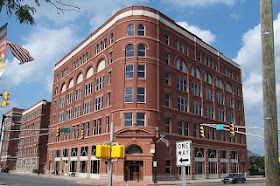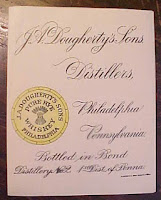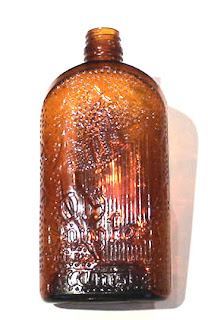According to a historian of the Adirondacks area, near the end of the 19th Century one of the few jobs open for Jewish immigrants to northern New York was peddling. Isaac Merkel was among them, remembered as a pack-peddler who struck it rich, founding a thriving liquor business, a brewery and a major upstate department store.
Merkel was born in Hessen, Germany, about 1845. His father apparently was a shopkeeper where he received his early training. About 1867 he married Jenette, from Prussia and a year older than he. The couple almost immediately set out for the United States and settled in Plattsburgh, Clinton County, New York, not far from the Canadian border.
Isaac found himself in immediate need of employment. Jenette was pregnant. When he arrived in the Adironack wilderness he found few compatible occupations. Peddling was the exception. If Isaac could not afford to open a store, he could carry it to others. We can imagine him on Sunday mornings, joining hundreds of other peddlers, waking up at dawn, shouldering a heavy knapsack and setting off on foot for a weeklong journey among the mountains and valleys. His route took him over poor country roads that were little more than cart paths to isolated Northern New York villages. As a peddler he would travel all day and sleep where he could find a warm place, often in summer camping out under the sky.
With his fellow peddlers Merkel would return home on Friday evening in time to attend Sabbath services. A synogogue had been established in 1861 to serve Plattsburgh’s Jewish population. By the time Isaac arrived, the congregation, after worshipping for years at temporary locations, had found a permanent home on Oak Street.
Meanwhile, Isaac was spurred on the by need to provide for a growing family. After the birth of his first son, Joseph, in 1868, other children were born regularly, at least three more sons and a daughter. Although a peddler’s life was hard there were opportunities to get ahead. Successful itinerants could buy a horse and wagon to carry their merchandise from town to town. We can assume Isaac was among them.

In time, Merkel’s intelligence and hard work paid off. In time he established a brewery, a liquor blending operation and distributorship, and ultimately a department store. The brewery was in Saranac Lake, one of the villages Isaac no doubt visited on his trading route. The brewery’s principal label was “Boss Lager,” sold in bottles and kegs. The company also produced other carbonated waters, some in bottles with elaborate applied labels as shown below.
As his sons grew to manhood, Isaac introduced them into his business. Two appear to have been particularly involved, David and Aaron. David is listed as his father’s partner in the whiskey business, Isaac Merkel & Sons. A 1913 Plattsburgh city directory lists them as “rectifiers and wholesale liquor dealers, bottlers and jobbers in cigars.” Their plant and office was at 56-50 Bridge St. and their retail store at 22-24 Bridge. Isaac was living at 32 Broad St. David was also a partner in a Plattsburgh pharmacy.


This caricature of Merkel’s apparently unmarried son obviously
 was a source of mirth for the family. The bachelor’s picture trademark was etched on shot glasses. On the glasses, the bachelor seems unhappy with his state and drinking away his sorrow at being single. The firm also issued a paperweight in the name of Bachelor Rye. Other Merkel brands were "Clinton County Club", "Wedding Bouquet", and "Wedding Bouquet Pure Rye."
was a source of mirth for the family. The bachelor’s picture trademark was etched on shot glasses. On the glasses, the bachelor seems unhappy with his state and drinking away his sorrow at being single. The firm also issued a paperweight in the name of Bachelor Rye. Other Merkel brands were "Clinton County Club", "Wedding Bouquet", and "Wedding Bouquet Pure Rye."
 As his enterprises met with success, Isaac was increasingly being recognized as a business leader in the community. He was cited in a 1891 Plattsburg history for his success as a merchant. In 1910 he was listed as treasurer of the Clinton Telephone Company and in 1915 as a director of Mountain Home Telephone Company. In 1900 he was active as a court juror and in 1905 served as a member of the Board of Education in Plattsburgh. Nor would Merkel ever forget his Jewish heritage. In 1897 he was elected president of the same synagogue he had attended as a peddler. He also served as an officer in the Plattsburgh Chapter of the Independent Order of B'nai B'rith.
As his enterprises met with success, Isaac was increasingly being recognized as a business leader in the community. He was cited in a 1891 Plattsburg history for his success as a merchant. In 1910 he was listed as treasurer of the Clinton Telephone Company and in 1915 as a director of Mountain Home Telephone Company. In 1900 he was active as a court juror and in 1905 served as a member of the Board of Education in Plattsburgh. Nor would Merkel ever forget his Jewish heritage. In 1897 he was elected president of the same synagogue he had attended as a peddler. He also served as an officer in the Plattsburgh Chapter of the Independent Order of B'nai B'rith.
About 1910 Merkel founded Plattsburgh’s primary department store, managed by son David. Isaac eventually would sell the brewery to a local resident. After that he sold out-of-town beer through Isaac Merkel & Sons. That firm did business until 1920 when it was shut down by the advent of Prohibition. The department store was handed down from generation to generation within the Merkel family and survived until 1993 when chain store competition forced it to close its doors. Thus ended the legacy of Isaac Merkel, a Adirondacks pack-peddler who traveled a long, hard road to prosperity.































.jpg)
















